VOL. 31, #2, Summer 2013
New Madagascar Aquamarine Discovery, Auction News, Gem News: Wall Street Journal Articles, Gem Heist News
- Home
- Newsletter
- VOL. 31, #2, Summer 2013
New Madagascar Aquamarine Discovery, Auction News, Gem News: Wall Street Journal Articles, Gem Heist News
New Madagascar Aquamarine Discovery
by Robert G. Genis
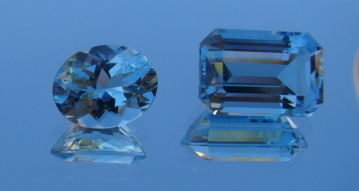 |
Collectors are always looking for a new hot gemstone that's inexpensive. Ideally, everyone wants to be in o n the bottom floor of the next Brazilian Paraiba tourmaline discovery. The Brazilian Paraiba story is unique but truthfully, may only happen once in a lifetime. However, as a general rule, collectors who buy gemstones before they become popular or known, generally see pretty nice increases in price appreciation as the material dwindles.
New Large Find
Madagascar Aquamarine has been intermittent for years but in January, 5 kilos showed up before the Tucson Gem Show. The market now has enough material to satisfy collectors, jewelers, and high end manufacturers. Large suites are being created for major necklaces. Jewelers can now get single stones for rings and necklaces and collectors can obtain single stones or suites of the new material.
Brief Gemology
Aquamarine is a beryl, the same family as emerald. Aquamarine gets its color from iron. Many aqua's are greenish blue, although the pure blues are considered the ideal. Aquamarine is 7.5 in hardness, which makes it durable for jewelry.
Size production
The rough material was very flat. Therefore, by the time the sawing procedure was finished, the vast majority of the goods are between 5-10 carats. The largest stone cut from the rough is 17 carats.
Color
I would describe the color as a very pretty pure medium blue with light tone. What is great about the material is the gems have no green or gray secondaries. These negative secondaries are generally the main reason to heat the material. Therefore, there is absolutely no reason to heat these rocks, an added plus for collectors. The few trials of heating the material did not change the color of the gems at all. Why bother? The material will be more in demand if not cooked!
One interesting tidbit is the color of all the material is extremely similar within tight tolerances. It doesn't matter if the stone is a 3 carat or a 10 carat. Generally, the larger stones hold the color better than smaller stones. Since the material is so similar, you cannot cherry-pick the better colors. My advice would be to buy what you can afford. This similarity has allowed the material to create 8 necklace suites. This is a real advantage for collector suites.
Clarity/Shapes/Cutting
As to be expected, the stones are all either Free of Inclusions (FI) or Lightly Included One (LI1) in the worst case. Primarily, the shapes are cushions and emerald cuts. The larger stones were all cut by experts in the United States and smaller stones were cut in China.
Conclusion
Every serious collector should add some of these goods in their portfolios while they are available and relatively inexpensive. It's usually financially prudent to purchase this material when it first hits the market. Remember Brazilian Paraiba tourmaline and Namibian Mandarin garnet and a host of others? You can only buy these from other collectors. You can buy for hundreds of dollars per carat not thousands! It doesn't matter if you collect one stone or an entire suite. It's probably time to get your check book out with this new Madagascar aquamarine. Enjoy.
Auction News
Christie's Hong Kong-May
This Magnificent Jewels sale reached $82.9 million or 81% by lot.
Here are the highlights:
* 8.88 Oval Burma ruby no heat sold for slightly over $2.8 million or $324,000 per carat. It's not a record but the price is pretty high. These stones continue to escalate. The estimate was $2.4 million to $3.7 million.
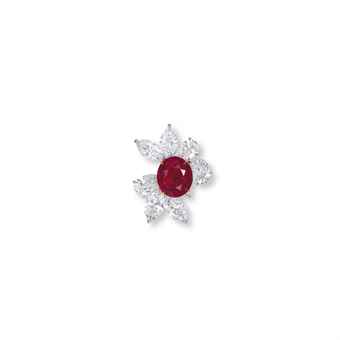 |
* 44.53 unheated Burma sapphire mounted in Cartier necklace sold for slightly above $2.8 million or $63,000 per carat. We are unable to place the value of the Cartier necklace and the diamonds on the total piece, therefore the price per carat may be high. The stone had a 2001 report from SSEF. The estimate was $2.3 million to $3.6 million
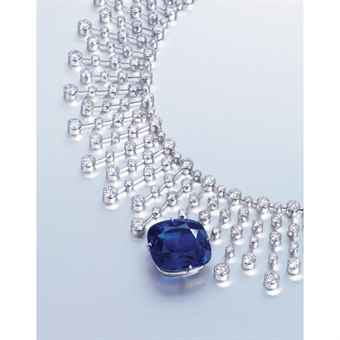 |
* 2.70 pear shaped fancy vivid blue diamond sold for $2.2 million or over $800,000 per carat. The piece was estimated at $1.2 million to $1.9 million.
* 17.95 no heat Sri Lankan sapphire mounted in Cartier necklace sold for $625,000. The stone was graded by Gubelin. The gemstone was estimated at $560,000-$776,000.
* 7.56 no heat Kashmir sapphire sold for $594,000 or almost $80,000 per carat. The stone was estimated at $310,000-$450,000.
* A 14.49 No heat Sri Lankan sapphire sold for $547,514 or over $37,000 per carat. The stone was graded by AGL. The estimate ws $168,000-$232,000.
* 23.86 unheated Burma sapphire sold for $500,917 or almost $21,000 per carat. The gem was graded by SSEF. The estimate was $310,00-$517,000.
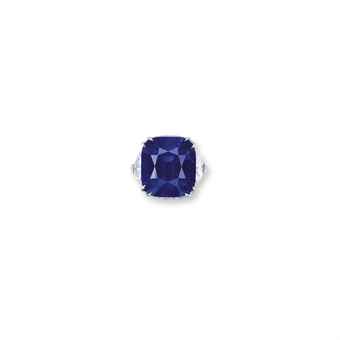 |
* 9.38 no heat Sri Lankan pink sapphire sold for $392,191 or over $20,000 per carat. The estimate was $155,00-$232,000.
Christie's Geneva-May
This Magnificent Jewels sale reached $102.1 million or 86% by lot.
Here are the highlights:
* 19.88 unheated Kashmir sapphire, known as the star of Kashmir, sold for $3.4 million or $171,000 per carat. The stone had an AGL JewelFolio which stated, "'Its size, provenance and outstanding quality signifies a gem sapphire of unique rarity." The estimate was $2.4-$2.9 million. This is a world auction recorded for a sapphire.
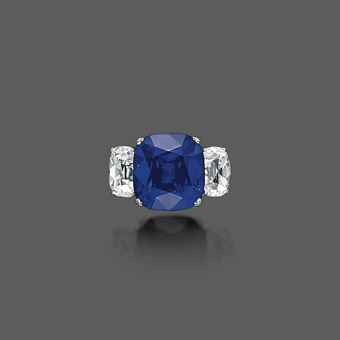 |
*1.92 GIA graded Fancy Red VS2 diamond sold for over $3.2 million or over $1.6 million per carat. The estimate was $1.9 to $3 million. This is a world record for a red diamond.
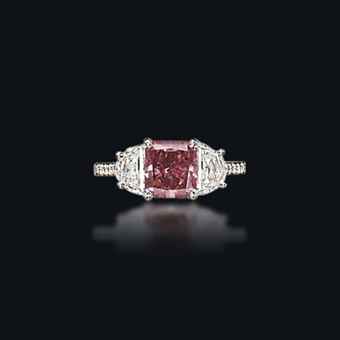 |
* 23.28 Colombian emerald sold for slightly over $1.8 million. The emerald was graded by the AGL as having no clarity enhancement and came with a JewelFolio. The estimate was $1.2-$1.7 million.
*7.92 Kashmir sapphire fetched almost $625,000 or $78,000 per carat. SSEF stated the gem was Kashmir and no heat. The estimate was $378,000-$441,000.
* 4.11 Burma ruby sold for $351,075 or $85,000 per carat. AGL stated the stone was not heated. The stone does not look vivid red and has a large window. The estimate was $199,000-$252,000.
Sotheby's Geneva-May
Sotheby's Geneva Magnificent and Noble Jewels sold 650 lots for over $74 million.
Highlights:
* 11.71 Kashmir sapphire sold for $1.1 million or $94,000 per carat. SSEF stated the stone was not heated. The estimate was $983,000-$1.5 million.
* 25 carat Colombian emerald sold for slightly over $1 million or $40,000 per carat. The stone is really windowed. AGL stated the stone had no clarity enhancement. Estimate was $940,000 -$1.4 million.
*25.51 emerald cut Burma sapphire sold for $695,000 or $27,000 per carat. SSEF stated no heat. The estimate was $470,000-$655,000.
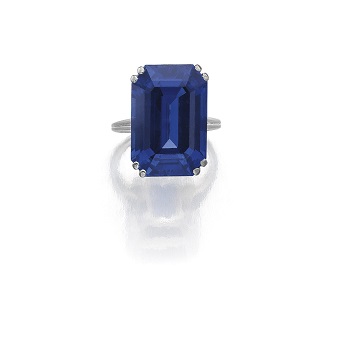 |
* 4.31 Burma ruby sold for $683,000 or over $158,000 per carat. The gem is not vivid red but purplish red. SSEF stated no heat. Estimated at $151,000-$245,000.
*15.28 Burmese sapphire sold for $482,450 or over $31,000 per carat. The gem was estimated at $190,000-290,000. SSEF stated no heat.
*6.99 Kashmir sapphire sold for $444,775 or $64,000 per carat. The estimate was $190,000-$285,000.
*28.21 Ceylon sapphire sold for $344,308 or slightly over $12,000 per carat. The estimate was $215,000-$315,000.
Gem News in the Wall Street Journal
Here are two excellent articles about the gem world and collecting recently published in the Wall Street Journal. I can remember back in the early 1980's, when most in the financial industry thought you needed electroconvulsive shock therapy if you invested in precious metals or precious gems. Wow. Times have really changed. Today it's considered prudent to diversify your portfolio with these hard assets. Your editor was interviewed in the first article and an interactive chart was made from our Gemstone Trends data. We worked closely with Shibani Mahtani. Watch her, she is a rising star. EDITOR.
Secret Rocks
WSJ.money
By Shibani Mahtani and Patrick Barta
May 17, 2013
Sapphires, rubies, and emeralds. The $10 billion gem industry is shrouded in beauty and mystery. Is change about to come?
TO HEAR RICHARD HUGHES tell it, the journey was like something straight out of "Indiana Jones and the Temple of Doom." One of the world's leading modern-day gem hunters, he was hell-bent on reaching the fabled jade mines of upper Myanmar-a jungle redoubt so remote and closely guarded that few living Westerners have ever laid eyes on it.
Before he could get close, he had to spend months ahead of his trip convincing Myanmar's secretive military, which controlled access to the country's mines, to let him in. Then he had to navigate some of the most punishing, malaria-ridden terrain east of the Congo, capped by a grueling climb along a dirt road his handlers said would only take seven hours to ascend. The trail quickly turned into a river of sludge under Myanmar's brutal monsoons, trapping vehicles in mud to their doors until teams of elephants showed up to haul them out. Days passed by as Hughes and his companions fought their way through the muck. In ramshackle villages along the way, residents smoked opium and told wild tales of the mining world beyond the ridges above.
But none of it could have prepared Hughes for what he found when he reached his destination three days later: a Wild West boomtown unlike anything he had ever seen. Stores were stocked with imported cognac and French perfume, while locals frittered away cash on roulette wheels, drugs and prostitutes. Fortune hunters tried just about anything to find jade-including diving into rivers with tubes hooked up to bicycle pumps onshore so they could breathe underwater. When people found dirty brown rocks they thought might contain jade, they thwacked them with hammers to see what kind of sound they made: If they rang like a bell, that was a good sign. In the main mines, meanwhile, armies of men marched along tracks hauling baskets filled with earth-more dirt, and perhaps more jade, from the depths below.
To Hughes, it was like stepping into the age of the pharaohs. "I thought, 'Wow, this is like building the pyramids,'" he recalls.
Hughes's inaugural journey to the Hpakant jade mines took place more than a decade and a half ago. But to a surprisingly large degree, Myanmar's famed gem mines have remained untamed, according to more recent visitors. The same, it turns out, could be said of the entire $10 billion "colored" jewels industry, the storied but murky business centered around 50 or so colored gemstones, such as jade, rubies, emeralds and sapphires, which have entranced the world's wealthy since the days of the Mughal dynasty and Catherine the Great.
Unlike the global diamond business, which is largely controlled by big companies like De Beers and painstakingly tracked by investors and Wall Street bankers, the colored gems world is still dominated by small miners and adventurers who wander some of the globe's most dangerous or underdeveloped places in search of treasure. The best stones tend to come from countries like Madagascar, Tajikistan, Colombia and Myanmar, where smuggling often is rampant, record-keeping is poor, and mine owners are sometimes reluctant to let outsiders visit for fear they might cut their own deals with the locals.
In some cases, experts like Hughes buy up stones from miners or middlemen and resell them to rich clients. Other gems find their way to the public via wholesalers who pick them up at auctions or markets in Thailand, India and other processing centers. One auction in Myanmar in 2011 alone netted $2.8 billion in sales. Either way, gem buyers-from newlyweds to collectors to fashionistas, who gobble up stones in New York, London or just about anywhere else-rarely have any idea where their gems came from and might not be able to find out for sure if they wanted to. When it comes to tracking basic data about which countries are producing the most stones, the industry is "very vague," says Jean Claude Michelou, a vice president at the International Colored Gemstone Association, a trade group.
Indeed, if you want to find the chief executive or major shareholders behind the best ruby or sapphire mines, good luck. In Myanmar, long considered the world's most important source of rubies and jade, many mines are controlled by the military or its close associates, including some who are targeted by U.S. sanctions established years ago to punish the country's harsh military regime. (Although many of those rules have been loosened over the past two years, since a new reformist government in Myanmar began rolling back decades of harsh military rule, some restrictions on new Myanmar stones remain.) But the stones can also come from private fortune seekers whose identities are largely unknown outside of their home bases. One of the gem tycoons Hughes met during his time in Hpakant was a former taxi driver who started out with a $23 boulder he bought from a passenger and then resold it for $5,000 to a jade trader. (When Hughes met the man in 1996, he posed for a photograph standing atop a pile of jade rocks that filled an entire room in his home.)
Still, while it's hard to track the industry's growth, experts say prices have climbed significantly in recent years, largely because supplies are erratic. Robert Genis, a Tucson-based gem hunter and dealer who got his start in the 1970s, says high-grade Myanmar rubies have quadrupled in retail value to more than $40,000 a carat since the mid-1990s, while Colombian emeralds have roughly doubled since a low in the early 2000s. Hughes, who has trekked across 30 or more countries for stones and now lives in Bangkok, says jade prices shot up 10-fold over the past five years, due largely to surging demand in China, though prices have eased recently.
And for people willing to hold on to their stones for a long time-or generations-the returns can be enormous. Consider the 62-carat Rockefeller Sapphire once owned by John D. Rockefeller Jr., who bought it from an Indian maharajah in 1934 and had it redesigned as a brooch for his wife. The family sold the stone in 1971 to a famous gem dealer for $170,000. Nine years later, it went on the block again and was sold for $1.5 million, and then resold for more than $3 million in 2001. Another famous sapphire, bought by 19th-century industrialist James J. Hill in the 1880s for his wife for $2,200, sold for just over $3 million at auction in 2007. And of course, there's the so-called Elizabeth Taylor Ruby, an 8-carat stone from Myanmar that was given to the late Hollywood star by Richard Burton in 1968 as a Christmas gift. In 2011, it was auctioned off for $4.2 million.
DIAMONDS ARE OF COURSE a lady's best friend, but colored gems continue to have a mystical allure that even the king of jewelry can't claim. Part of the romance is tied to the stones' luminous beauty and scarcity. For many wealthy people, especially in Asia, there's nothing quite like having a bag of shiny stones they can carry around or stash away-and sell-in case of emergency. That has become even truer since the global financial crisis, which left many affluent people hungry for alternative ways of storing wealth.
It doesn't hurt that colored stones come with such atmospheric histories, making them all the more addictive. The Mughal dynasty, whose emperors included Shah Jahan, builder of the Taj Mahal, had its famous Peacock Throne inlaid with rubies and other precious stones. Chinese leaders were known to favor jade as far back as 3000 B.C., while Russians placed a roughly 400-carat red spinel, believed to date back to the 1400s, in their imperial crown. More recently, Prince William gave Kate Middleton a sapphire engagement ring that had belonged to his mother, Princess Diana.
Finding big new stones to quench the world's demand, though, isn't easy. That's where gem hunters come in. Genis, the Tucson-based dealer, says he got started in college, when he pulled out maps to see where the world's most coveted natural resources, including tin, gold and copper, were located. It was a tiny green symbol on Colombia, depicting emerald deposits, that captivated him the most. He sold his stereo and a secondhand car to scrape together $1,000 for his journey. "I knew I did not want to come back broke," Genis says.
After a bus ride to California's border with Mexico, some trains and some hitchhiking, Genis landed in Bogota's emerald district and spent his remaining cash on gems. Back in the U.S., he doubled his money selling the stones. "Suddenly I had $1,000 more, and I thought, 'Hey, this is much better than going to school,'" he recalls. After repeat visits, he was making enough to fly to Colombia instead of taking the bus, with stops for fun in the Caribbean on the way home.
These days, Genis trusts other people to find many of the stones he sells, including a New York-based associate he met at a gem conference who is from Myanmar and has connections at its famous Mogok ruby deposits. Although not as wild as Hpakant, Mogok's mines are also closely guarded by Myanmar's military-and revered worldwide. People who have seen them describe a place trapped in a time warp in a remote mountain valley with glittering gold pagodas where practically everyone dabbles in the gem trade, even the local bakeries, which show visitors gems and the day's baked goods.
The enduring appeal is obvious when one considers what people can land. Genis's latest find: a 39-carat sapphire, sourced through his Myanmar associate that now is waiting to be auctioned at Sotheby's. Genis says he estimates the stone could fetch up to $1 million, with bidding wars common at the prestigious auction houses where they are sold. "For many of these collectors, the habit is almost like heroin-when you start, you can't stop," he says.
Eager buyers are even lining up in Yangon, Myanmar's biggest city and a place that is opening rapidly to tourists, as Myanmar's government eases restrictions on foreigners. At the Bogyoke Aung San Market downtown, in a crumbling colonial building, middle-aged tourists shuffle through cobbled streets while shopkeepers spit betel nut on the floor, staining their teeth and lips red. The gems on offer are hardly like the 39-carat stone Genis recently uncovered, but they offer visitors a chance to buy a token of the industry's glamour and romance.
"Before I came here, everyone would go on and on about how beautiful Burmese rubies were," said Pamela Bowen, a 54-year-old from Florida who was in Yangon for the first time, referring to the country's colonial name of Burma. With so much talk about Myanmar stones, she said, she figured they were a "must buy," and paid about $550 for ruby earrings and a ruby ring for herself and her sister back home.
AS DEMAND FOR COLORED gems keeps growing, though, the question remains: Can the industry get a handle on itself? One part of the answer may be half a world away from Myanmar, in London, in the city's prestigious Mayfair area. There, a group of mining-industry veterans are making their own plans to get more colored stones.
Their company, Gemfields, is trying to become an industry powerhouse, something like the De Beers of colored gems. Backed by a former chief executive of BHP Billiton, the world's biggest mining company, and listed on the London Stock Exchange, Gemfields says it is aiming to secure rights to a large enough percentage of the world's production of major gems and introduce modern mining processes so it can ensure a more predictable supply, while investing heavily in marketing to make the stones better known.
Ian Harebottle, the company's South African chief executive, says colored stones used to be as popular as diamonds-until the 1940s, when De Beers began cranking up its marketing budget, with slogans like "a diamond is forever." Now, colored-gems sales are only a fraction of the $70 billion international diamond trade, and the small-time miners who dominate the business don't have the money or scale to do much about it, he says. "Colored stones were going backwards," Harebottle says.
Gemfields already produces 20 percent of the world's emeralds, from a large mine it co-owns in Zambia. The company says it has as much as 40 percent of the global amethyst supply, and it is starting to produce rubies from a major deposit in Mozambique. Gemfields wants to expand elsewhere-including in Myanmar, if its government keeps reforming and the human-rights situation there improves, Harebottle says.
Gemfields also just bought Fabergé, the storied jewelry brand from the days of the Russian czars. The idea is to use Fabergé, which has boutiques worldwide, to market some of its gemstones in the ultraluxury space as it creates one of the first "mine to market" supply chains for colored gems. It also has signed up Hollywood actress Mila Kunis to lead a fresh marketing campaign, featuring images of the starlet wearing a Romanov-style necklace-inspired by an 1880s design-with 79 emeralds from Gemfields's Zambian mines.
Gemfields's efforts come amid other attempts by investors to bring more modern practices to the industry, including making pricing data more widely available and improving grading and tracking practices so that consumers can get a better idea of what their stones are worth and where they came from. Officials at the International Colored Gemstone Association, for instance, are pushing to create a system to trace the origins of colored gems. The association's Michelou says countries including Colombia, Tanzania and Sri Lanka have expressed interest.
Other companies, meanwhile, are touting mine-to-market supply chains and otherwise updating production. They include TanzaniteOne Mining and its parent, London-listed Richland Resources Ltd., which have helped transform the tanzanite market by investing in formerly artisanal mines near Mount Kilimanjaro, which are the world's only known deposits of the rare blue stone. Meanwhile, even the mines in Hpakant in Myanmar have seen more mechanization in recent years, with earth-moving machines replacing many human workers, though the site overall remains unruly. All this could one day make colored stones more valuable if it helps make supplies more reliable and increases demand.
"The colored-stone industry will probably go in that direction, [toward] more rational, more formal mining," says Russell Shor, an analyst at the Gemological Institute of America, one of the world's leading authorities on gems. "It'll be a slow process, but I think that's the future."
Yet plenty of people, including many gem hunters, remain skeptical. The world's main gem deposits, they contend, are often too small to justify major investments, and sometimes may be better exploited with primitive hand tools. The mines are scattered so widely and in such unruly places that it could be too complicated-not to mention, expensive-to bring them into the modern era. "How many trillions do you have?" asks Genis. "With the exception of diamonds, most gem sources are ancient, and the best gems are long gone." Trying to integrate the mines, he says, "would be practically impossible."
Hughes, the gem hunter in Bangkok, agrees. People have always been interested in bringing more order to the colored-gems trade, he says. But Mother Nature protects her treasures well, hiding them in hard-to-reach places, he says, and the people that look after them have little incentive to surrender control to London, Wall Street or anywhere else for that matter.
"Gemstones are different from other kinds of mining," Hughes says, because there's a high concentration of value in very small areas and relatively few stones. Plus, only people, not machines, can separate valuable specimens from worthless ones-and that includes the artisanal miners who now have much of the action. If big companies try to impose more order, he says, "there's always going to be people who can get around it."
Collectors Focus on Jewels as Investments
WSJ Hard Assets
by Kelly Crow
May 9, 2013
This article accurately describes the refugee mentality of the wealthy. Let's face it-gems are the only portable asset you can safely escape with to a foreign country. In today's world, this gives solace to the people with assets. Many consider gems just in case insurance. EDITOR
Blue-chip paintings may be getting the most attention in this volatile art market, but jewels are quietly starting to shine as buyers seek alternative investments and portability.
Last month, Christie's sold a pink diamond the size of a thumbnail to an international collector for $39.3 million. Sotheby's sold an even smaller pink diamond three years ago for $46 million-more than anyone has ever paid for a canvas by Camille Pissarro or Paul Gauguin. Next Wednesday in Geneva, Christie's will offer up a pear-shape diamond dubbed the "Absolute Perfection" that's about as big as a golf ball. Asking price: $20 million to $30 million.
Blue-chip paintings may be getting the most attention in this volatile art market, but jewels are quietly starting to shine. With gold prices down and currency values roiling, some investors and collectors are scouring for creative alternatives where they can store cash-and move it around quickly in a pinch. Why else would investors sock $1 billion in a decentralized, online-only currency like Bitcoin that didn't even exist six years ago? Alan Silbert, who last week launched a website accepting Bitcoins for its $2 million condominiums and $25,000 watches, said, "People are exploring ways to exercise more control over their money-they just want to diversify their assets."
For this reason, diamonds-arguably the hardest asset around-are no longer just a girl's best friend. Men are the ones primarily responsible for moving the $71 billion U.S. market for jewelry now, and not because they want to buy a few baubles for their wives on special occasions. Men, as well as some women, are increasingly shifting a portion of their assets into diamonds and colored gems as pure investments, attracted by jewelry's portability and global appeal, experts say. Christie's jewelry specialist Rahul Kadakia said several men have walked into his office lately, seeking advice on how to "invest $100 million in jewelry over the next five years-and they've done it."
Martin Rapaport, a former diamond cleaver who built the industry's biggest diamond-trading network RapNet, said a billionaire friend recently bought 100 single-carat diamonds and had them strung together in a Roaring Twenties-style strand. That way, if the man's fortunes shifted, he could step on an airplane with his nest egg, worth roughly $1.1 million, looped safely around his wife's neck. "If the world gets a computer virus and suddenly you need to move $10 million in 48 hours, gold will set off metal detectors and too much cash gets cumbersome," Mr. Rapaport said, "but you slip on a $5 million ring and a $5 million necklace and you've got no problems."
Judith Price, president of the National Jewelry Institute, said a "refugee mentality" has seeped into the entire jewelry field over the past decade, ratcheting values for everything from natural pearls to ornate brooches by Van Cleef & Arpels. "If there is a problem, people want to feel like they can escape," Ms. Price said. "You can't do that with a Rodin tucked under your arm, but think about how a tiny a jewel is-you can slip it in your pocket and walk away."
Diamond prices often climb when stocks are falling and vice versa. But the long view on diamond values is reassuring, jewel and art experts say: Last month, the average asking price for a one-carat diamond among gem dealers was roughly $10,500, up 31% from a one carat's going rate six years ago, according to the RapNet Diamond Index, which tracks diamond prices among 12,000 gem dealers around the world. During that same period, Standard & Poor's 500 index increased 14%.
Jewelry has long served as a pretty way to store and display wealth, from King Tutankhamen, who was entombed with his collection, to Henry VIII, who instructed his jewelers to embed his initials in just about every bauble he wore. Today a few royals are still considered heavyweight buyers of jewelry, specifically the sultan of Brunei and the emir of Qatar.
The difference is that investors dominate the jewelry market now, and their tastes and collecting habits are determining price levels for all sorts of gems. In China, industrial tycoons mainly covet D-flawless diamonds-defect-free gems. This preference for perfection revealed itself when Chinese investors even sidestepped larger but slightly clouded stones in favor of smaller, flawless varieties, said Sotheby's specialist Lisa Hubbard. Elsewhere in the world, though, bigger still appears to sell better: Last month, Sotheby's sold a 75-carat pear-shape white diamond for $14.2 million; the seller paid $4.3 million for it in 2001, earning a 230% return.
Collectors in China have also catapulted asking prices for colored diamonds-particularly in rare shades of pink and blue. Christie's says the last time its $39 million "Princie" pink diamond came up for auction in 1960, it sold for $1.3 million.
India and the Middle East, on the other hand, seem more smitten with natural pearls, a run-up that kicked off in 2007 when two strands of pearls that once belonged to the Maharajah of Baroda sold for $7.1 million, far above the $6 million estimate. Last May in Geneva, a man also paid Christie's $4.5 million for an emerald-encrusted turban ornament, called a sarpej, that was estimated to sell for $800,000.
Across Europe and the U.S., the jewelry field is seeing an influx of contemporary art collectors who are buying tried-and-true gems partly as a way to offset the risk of their newer, untested art holdings. Peter Brant, the industrialist-publisher who collects Andy Warhol and Urs Fischer, buys whimsical pieces by Paris jewelry designer Joel Arthur Rosenthal, known as JAR, for his model wife, Stephanie Seymour-and he's also bought a few investment-worthy diamonds from London jeweler Laurence Graff.
Greek financier Dimitri Mavrommatis, who collects Sèvres porcelain, Impressionist paintings and contemporary art, said he started buying a "fantastic collection of stones" over the past decade including pink, blue and yellow diamonds and Kashmir sapphires. His "masterpiece" is an 8.6-carat ruby called the "Graff Ruby" because Mr. Graff paid Christie's $3.6 million for it in 2006. Mr. Mavrommatis said he bought the ruby from Mr. Graff a year later for an undisclosed sum and could likely resell it now for almost $10 million. Although the same instinct for quality guides Mr. Mavrommatis's collecting in both areas, his paintings hang in his Paris apartment and his gems remain out of sight, in a safe. "You can't buy a painting or a jewel first because it's an investment, especially when you pay through the roof," he added. "I buy them firstly because I love them."
Mr. Graff, who also collects contemporary art, said, "Diamonds are treasure, and the wealthy always want treasure."
Jewelers and auction houses are also reaping the benefits of their decades long campaign to position-and price-jewels as artworks rather than ornaments. When Christie's specialist François Curiel started selling jewelry at Christie's 40 years ago, he said its black-and-white catalogs rarely showed the pieces coming up for sale. Catalog descriptions never said more when less would suffice-say, "Ruby brooch, invisibly set, Van Cleef, 1930."
Now, auction houses are doing whatever they can to appear accessible to novices. Anyone who stopped by Christie's jewelry preview last month in New York could have bought a 297-page catalog with pages of descriptions devoted to its priciest pieces like the "Princie," which had been mined in India 300 years earlier and carried a $30 million estimate.
Inside the crowded room, most of the jewels were arranged by color in velvet-lined cases, but the "Princie" got its own darkened room. Since one of the diamond's selling points was its ability to change hues-from cotton-candy pink to fuchsia-under fluorescent light, a bulb was positioned over its case to flicker on and off. A video projected on a nearby wall traced its origin to the famous Golconda mine in India and its past owners like the Nizam of Hyderabad, who mentioned it in an inventory log in 1700. In 1960, the gem was resold and nicknamed the "Princie" after the 14-year-old Prince of Baroda.
When the "Princie" came up for bid a couple of days later, a model in a pink designer-ball gown held up the stone for one final glimpse in the saleroom. Minutes later, the gavel fell and a telephone bidder won it for $39.3 million, making it the second-priciest gem to ever sell at auction.
Over at rival Sotheby's, the campaign is also paying off. Ms. Hubbard said the house auctioned off $460.5 million worth of jewelry last year, up 58% from its sales in 2007-the peak of its last market cycle.
In some cases, men who got started investing in jewels a few years ago have started branching out to collect other historic periods. Boston collector Fred Sharf collects 1950s "high style" pieces designed by Van Cleef, but he's lately started buying "retro" pieces that were made with "ordinary stones" like citrine during the Depression and World War II.
Miami radiologist and design collector Al Eiber said he didn't consider jewelry to be part of his net worth two decades ago when he and his wife, Kim, started buying $5,000 wiry necklaces designed by sculptor Alexander Calder. But now, Mr. Eiber sees similar pieces of Calder's "miniature sculptures" trading at auctions for up to $500,000 apiece, and he said, "I wish I'd bought more. If I look back at what I've collected, the jewelry has probably done better than anything else I've bought."
Because so much of the world's jewelry is still made for, and marketed to, women, the collecting of it can prove a little isolating for men. Yvonne Markowitz, a jewelry curator at the Museum of Fine Arts in Boston, said men rarely talk about the pieces they're collecting in the way they might show off a blue-chip painting. Investment jewels stay in the vault and rarely come out, even for parties. Mr. Sharf said he was pleased when the Cooper-Hewitt National Design Museum borrowed his ruby flower Van Cleef brooch called the "Command Special" to exhibit. His wife Jean doesn't even put it on. "She never wears it-it never sees the light of day," he said, laughing.
Michael Rotenberg, a Boston collector who manages apartment buildings, said he's grown braver lately and started wearing the $200-$500 lapel pins he collects from studio jewelers. But he only tends to wear pieces created from manly materials like electrical tape and twigs, and he only wears them to arty events like museum openings, not the office.
His wife, Karen, collects jewelry as well, and she said she is happy to share the pursuit. She does have a rule of her own, though: "I told him he can do this so long as his brooches aren't bigger than mine."
Gem Heist News
Enough serious gem information. Let's finish this newsletter with some gemstone levity! EDITOR
$50M diamond heist soon turned comic
New York Times News Service
By Doreen Carvajal
June 16. 2013
When squads of fake police officers arrived in a whirl of blue lights, they struck with clockwork precision, plundering closely guarded packets of diamonds from the cargo hold of a parked plane and fleeing without troubling the passengers.
Since the theft on the windblown tarmac of the Brussels airport in February, though, the episode has veered from thriller to comedy, featuring a roundup of unusual suspects who, naturally, came together in Casablanca, Morocco.
The robbery was marked by meticulous planning, inside information and swift execution - eight armed men in 11 minutes - that left investigators marveling. As the investigation has deepened in Morocco, Belgian officials conceded last week that the value of the cargo stolen might be far higher than the $50 million first estimated.
But the frantic effort to sell the diamonds afterward was so ham-handed that some who watch the industry have begun to doubt that the robbers were after diamonds at all, but were instead seeking hard cash.
Since they were arrested after trying to sell the diamonds, most suspects have denied involvement, while others offered a defense rarely employed by the suave celluloid jewel thieves or their conspirators: stupidity.
The flawed second stage of the robbery is emerging in various legal proceedings since more than 30 people were detained in dawn raids last month by investigators in Belgium, France and Switzerland. The suspects include a French former convict with a restaurant in Casablanca called Key West and a wealthy Geneva real estate investor who insists that he was conned into hiding a paper sack of gems.
Today he can't understand himself why he was so stupid," said Shahram Dini, the lawyer for Pascal Pont, 56, the real estate investor, who has been released from prison but remains under investigation on suspicion of receiving stolen property. He was naïve. He is someone who has a thriving real estate business, doesn't need more money and has a family and children. It wasn't for himself. It was a favor for someone who charmed him and also scared him."
The key relationship, which helped crack the case, is the tie between Pont and Marc Bertoldi, 43, the Casablanca restaurateur, with a sideline exporting luxury cars and a prior conviction in France for trafficking in stolen cars. Bertoldi's name first surfaced in an unrelated Swiss inquiry, prompting a wiretap that connected him to the robbery in Belgium, according to the Swiss prosecutor, Marc Rossier.
Last month, a grim Bertoldi was rushed into a courtroom in Metz, France, for an extradition hearing. Wearing jeans and a pink Ralph Lauren sweater, with his cuffed hands covered by a yellow blanket, he denied involvement in the robbery.
The judges nonetheless agreed to send him to Belgium, based on information from wiretaps and GPS tracking that placed his car near the robbery. Prosecutors said that Bertoldi also warned a friend that he would be unreachable on the day of the theft. Two days later, according to the Belgian authorities, he was overheard boasting about his part in the robbery and urging his friend to "watch television."
His lawyers appealed the ruling, arguing that Pont had falsely implicated Bertoldi in exchange for his release.
Dini said that Pont was aware of his friend's checkered past, but that Bertoldi was so droll that Pont came to admire and fear him. Handed bags of diamonds, Pont just took them. "In my line of work," Dini said, there are people who do things that are really stupid, because they don't have the force of character to say no."